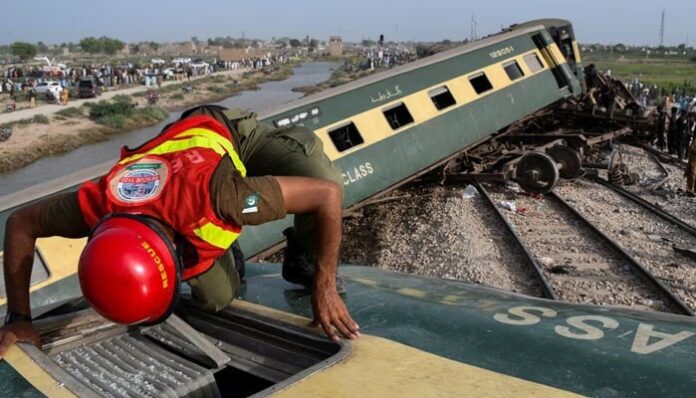In a heartbreaking incident, the Railway department is set to commence an extensive inspection of the site where the Hazara Express tragically derailed in the district of Sanghar’s Nawabshah. This harrowing train crash resulted in the loss of more than 30 lives and left 130 individuals injured. The goal of this investigation is to meticulously gather evidence that will shed light on the factors contributing to this devastating accident.
Unraveling the Hazara Express Derailment
The nation of Pakistan once again found itself mourning a catastrophic train mishap. On a fateful Sunday, a shocking event unfolded as ten carriages of the Havelian-bound Hazara Express veered off course close to the Sahara Railway Station, situated in the Nawabshah district of Sindh. The tragic scene was located approximately 275 kilometers away from Karachi, sending shockwaves through the entire country.
Disruption and Restoration of Railway Operations
The aftermath of this heart-wrenching incident brought about significant disruptions in the operation of train services. The section of track directly impacted by the crash remained closed, causing suspension and delays. However, after an arduous 18-hour period, the down-track was successfully restored, enabling train departures from various stations to commence, albeit with delays.
Progress Toward Full Restoration
As the railway authorities diligently work to restore normalcy, the process is ongoing. The restoration of the affected track is a complex task that demands time and expertise. While progress is being made, it is anticipated that additional hours will be required before complete restoration is achieved.
Dedicated Efforts and Expert Insights
Ali Mohammad Afridi, an Inspector with the Federal Government’s Railways, provided valuable insights into the ongoing efforts. He reported that the up-track is expected to be fully operational within the next four to five hours. Speaking from Sanghar, Afridi disclosed that an upcoming site inspection is scheduled, and the formal inquiry will commence within the subsequent four to five days, subsequent to recording statements from relevant individuals.
Repairing and Scrutinizing the Railways
The extent of the impact caused by the train crash is extensive, affecting approximately 300-400 kilometers of railway track. Repair works are actively underway to rectify the damage and ensure the safety of future train operations. Teams are meticulously examining the track, coaches, and locomotives to identify the root causes of the accident. Notably, the marks visible on the affected tracks are indicative of issues with nut bolts and wheel flanges.
Humanitarian Response and Medical Care
The Peoples Medical Hospital in Nawabshah took swift action in the face of adversity, promptly responding to the crisis. Over 120 injured individuals were promptly transferred to the medical facility, where they received expert care and treatment. The hospital administration has confirmed that a significant number of those treated have already been discharged, while 30 individuals are currently undergoing treatment for their injuries.
Remembering the Departed and Seeking Answers
As the nation grieves the loss of lives, the families of 29 individuals have claimed and laid their loved ones to rest. Tragically, the remains of two women who could not be identified remain within the hospital. The haunting scenes of overturned train carriages and the grim sight of individuals trapped beneath the wreckage serve as a stark reminder of the magnitude of this tragedy.
A Community United: Swift Action and Cooperation
In a moment of crisis, the local communities of Sanghar and Nawabshah demonstrated immense solidarity and compassion. Before official rescue teams could arrive, these brave individuals initiated rescue efforts, evacuating a considerable number of wounded passengers to medical facilities. Their swift response exemplifies the strength and resilience of these communities in times of adversity.


